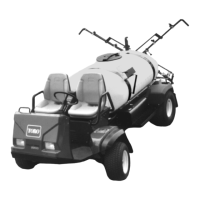22
PRE-STARTING CHECKS
Safe operation begins before taking the vehicle
out for a day's work. You should check these items
each time:
1. Check tire pressure. (See page 19)
NOTE: These tires are different than car tires,
they require less pressure to minimize turf
compaction and damage.
2. Check all fluid levels and add the appropriate
amount of TORO specified fluids if any are found
to be low.
3. Check Brake Pedal operation.
4. Check to see that the lights are working.
5. Check for oil leaks, loose parts, or any other
noticeable malfunctions. Make sure engine is off
and all moving parts have stopped before
checking for oil leaks, loose parts, and any other
malfunctions.
If any of the above items are not correct, notify
your mechanic or check with your supervisor
before taking the vehicle out for the day. Your
supervisor may want you to check other items on
a daily basis, so ask what your responsibilities are.
STARTING ENGINE
1. Sit on Operator's Seat and engage Parking
Brake.
2. Make sure Traction Pedal is in NEUTRAL
position.
3. Make sure Spray System is in the "OFF"
position.
3. Move the Throttle Lever 1/4 to 1/3 throttle.
4. Pull the Choke Control out to full choke
position, if cold starting engine.
5. Insert Key into Ignition Switch and rotate it
clockwise to start engine. Release Key when
engine starts.
IMPORTANT! Do not hold Key in starting
position longer than 10 seconds at one time. If
the engine does not start, wait at least 60
seconds before attempting to start again.
Continuous cranking will burn out the Starter
motor. If the engine develops sufficient speed
to disengage the Starter, but fails to continue
running, the engine must come to a complete
stop before attempting to restart the engine. If
the Starter is engaged while the Flywheel is still
rotating, the Starter Pinion and Flywheel ring
gear may clash, resulting in damage to the
Starter. If the Starter does not turn the engine
over, shut off the engine immediately and do
not attempt to start the engine until the
condition has been corrected. Do not "jump-
start" using another, larger battery.
NOTE: Starter motors are pre-lubricated.
Brushes normally require servicing only after
extended use.
6. Gradually push the choke in to the OFF
position after the engine is running.
7. Turn Steering Wheel to the left and right to
check steering response.
8. Position the Throttle Lever at the desired
engine RPM.
DRIVING VEHICLE
1. Release Parking Brake.
2. With the operator's foot positioned on the foot
pedal as shown in (Fig. 19 page 23), slowly apply
pressure with the toe on top of the pedal away
from the operator to move in a FORWARD
direction. Position toe on the "tail" of the pedal to
move in a REVERSE direction.
3. Slowly moving the Traction Pedal to the
NEUTRAL or "centered" position will bring the
vehicle to a stop. Be sure to allow the vehicle to
stop before changing between forward and
reverse motion.
4. Use the Throttle Lever to adjust the engine
RPM if necessary.
OPERATING INSTRUCTIONS
Engine exhaust gases contain poisonous
carbon monoxide.
Carbon monoxide is odorless, colorless
and can cause death if inhaled.
Avoid inhaling exhaust fumes and never
run the engine in a closed building or
confined area.
WARNING

